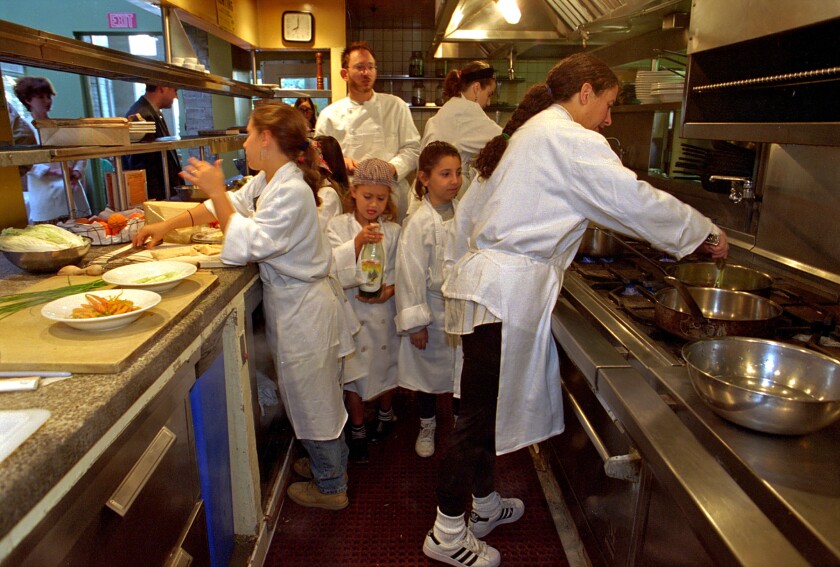Mark Peel, the revolutionary chef who helped pioneer California cuisine and establish Los Angeles as a dining destination, died Sunday. He was 66.
Peel died Sunday afternoon at Kaiser Permanente Los Angeles Medical Center on Sunset Boulevard, according to his daughter Vanessa Silverton-Peel. He was diagnosed with an aggressive form of cancer only nine days ago, she said.
Peel started working for chef-restaurateur Wolfgang Puck at Ma Maison in 1975, and helped Puck open Spago in West Hollywood in 1982, ushering in a dining renaissance in Los Angeles.
But he first learned to cook at a small restaurant in the Sonoma Valley where he was a dishwasher during high school. “I wanted to be a doctor like everybody else,” Peel told the New York Times in 1986. But instead of finishing premed, he transferred to a hotel and restaurant program at Cal Poly Pomona.
“I still remember him as a young guy going to Pomona,” Puck said. “He started working for me on the weekends [and] then would come more and more.”
At Ma Maison, Peel began as a vegetable boy and worked his way up to assistant chef. From there, he cooked at Michael’s in Santa Monica, where he met his now-former wife Nancy Silverton in 1979, and then moved on to Chez Panisse in Berkeley.

Nancy Silverton, right, and Mark Peel, rear, make pasta with daughters of employees and their daughter Vanessa, left, at Campanile.
(Iris Schneider / Los Angeles Times)
He made a name for himself as chef de cuisine at Spago, where he created extravagant pizzas and cuisine that celebrated the best local produce. “I remember he said, ‘I have a pastry chef,’” Puck said. “I told him I already have a pastry chef but he insisted I hire her. Her name was Nancy Silverton.”
Puck, Peel and Silverton were a powerhouse team in the kitchen.
“It was so hard when we opened but we all believed in the same thing: to make people happy and give people a great experience,” Puck said. The restaurant garnered national recognition and multiple culinary awards under the trio’s leadership.
“He really had his own style and he loved working the grill,” Puck said. “He was running Spago when it was so busy, but he always kept his cool and never screamed at anybody in the kitchen. He always wanted the food to be perfect; he didn’t care how long it took.”
Peel and Silverton married in 1984, and in 1986, they left Spago and moved to New York City to run Maxwell’s Plum, only to return to Los Angeles after a year. They were back at Spago for a short time, then opened their own restaurant in 1989.
Peel and Silverton bought the space at 624 S. La Brea Ave. and transformed it into Campanile, an eatery that, in its heyday, was the quintessential Los Angeles restaurant. (They opened La Brea Bakery a few months before Campanile, and sold it in 2001; it’s now a brand recognized around the world.)
The restaurant business is terrifically unstable, but Campanile endured for 23 years, as did the distinct myriad facets of Los Angeles dining that were born in its kitchen. This is where the concept of farm-to-table was introduced to countless Los Angeles diners. When the restaurant first opened, Peel drove to Chino Farm in Rancho Santa Fe multiple times a week to procure the ingredients for his seasonal plate of grilled vegetables.
In a 2012 ode to Campanile, the late Jonathan Gold credited the restaurant with starting the grilled-cheese phenomenon, the idea of a pop-up restaurant within a restaurant, and the urban-rustic aesthetic now commonplace on both coasts.
Peel was the author or co-author of several cookbooks, including “New Classic Family Dinners.” He co-authored two cookbooks with Nancy Silverton: “Mark Peel & Nancy Silverton At Home: Two Chefs Cook for Family and Friends” and “The Food of Campanile.”
Peel’s most recent venture was the Prawn Coastal food stand at Grand Central Market.
“My dad in so many ways was really ill-fit for the emergence of this whole rock star-chef era,” said his daughter Silverton-Peel. “He always thought of himself as a cook, he thought of himself as doing manual labor.”
As a father to five, Peel was silly and fun-loving: Always the first to jump in the pool, he showed up at graduations and recitals, albeit often late.
“He was the most tardy person you’d ever met,” Silverton-Peel said. “Once he was there, he was so happy to be there.”
One of the last things he told her was how sad he felt that he wouldn’t be around to embarrass his grandchildren. Silverton-Peel has a 2-year-old and an infant.
He was pretty good at that with her, though. Growing up, she said he’d show up to pick her up from bar and bat mitzvahs in full chef’s whites — “covered in fish blood and smoke” — and insist on hitting the dance floor with her before the party was over. He snagged a dance at Campanile, too, when he let her host an after-prom party there her senior year of high school.
He’d often joke that his giant pickup truck stuck out in the Oakwood School carpool line of Volvo station wagons. It was a Dodge Ram he used to pick up his weekly haul from the Santa Monica Farmers Market for Campanile — a task he always did himself.
“He wasn’t the guy who was always looking for attention, he was the guy who wanted to feed people really good food,” Silverton-Peel said. “I think he was so much more influential than he ever really took stock of.”